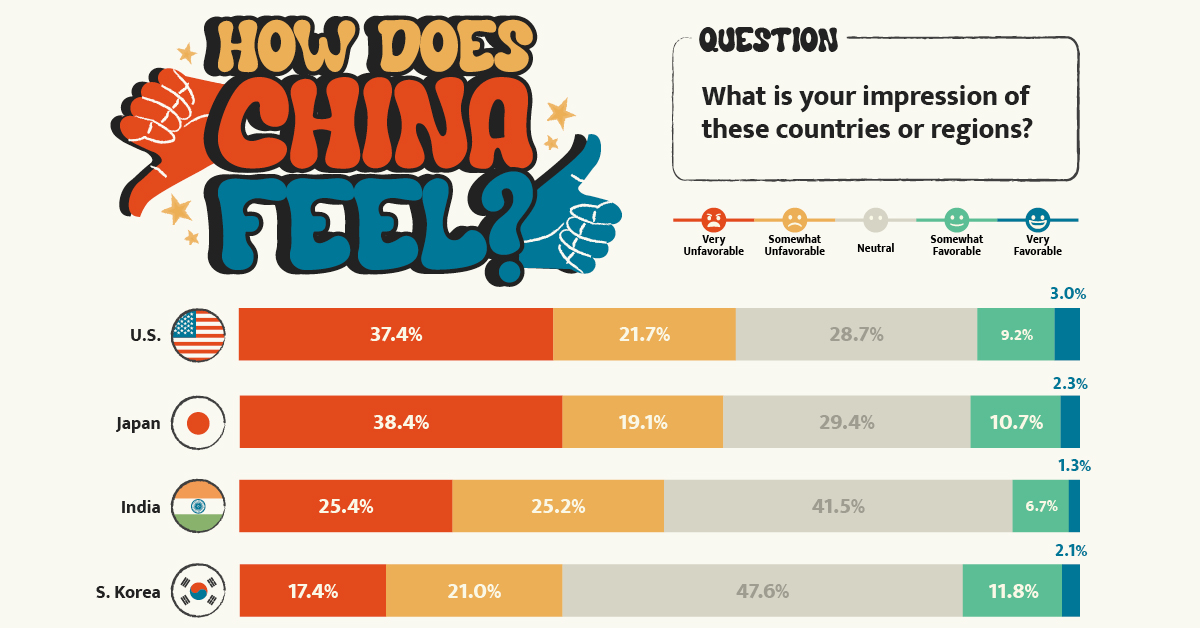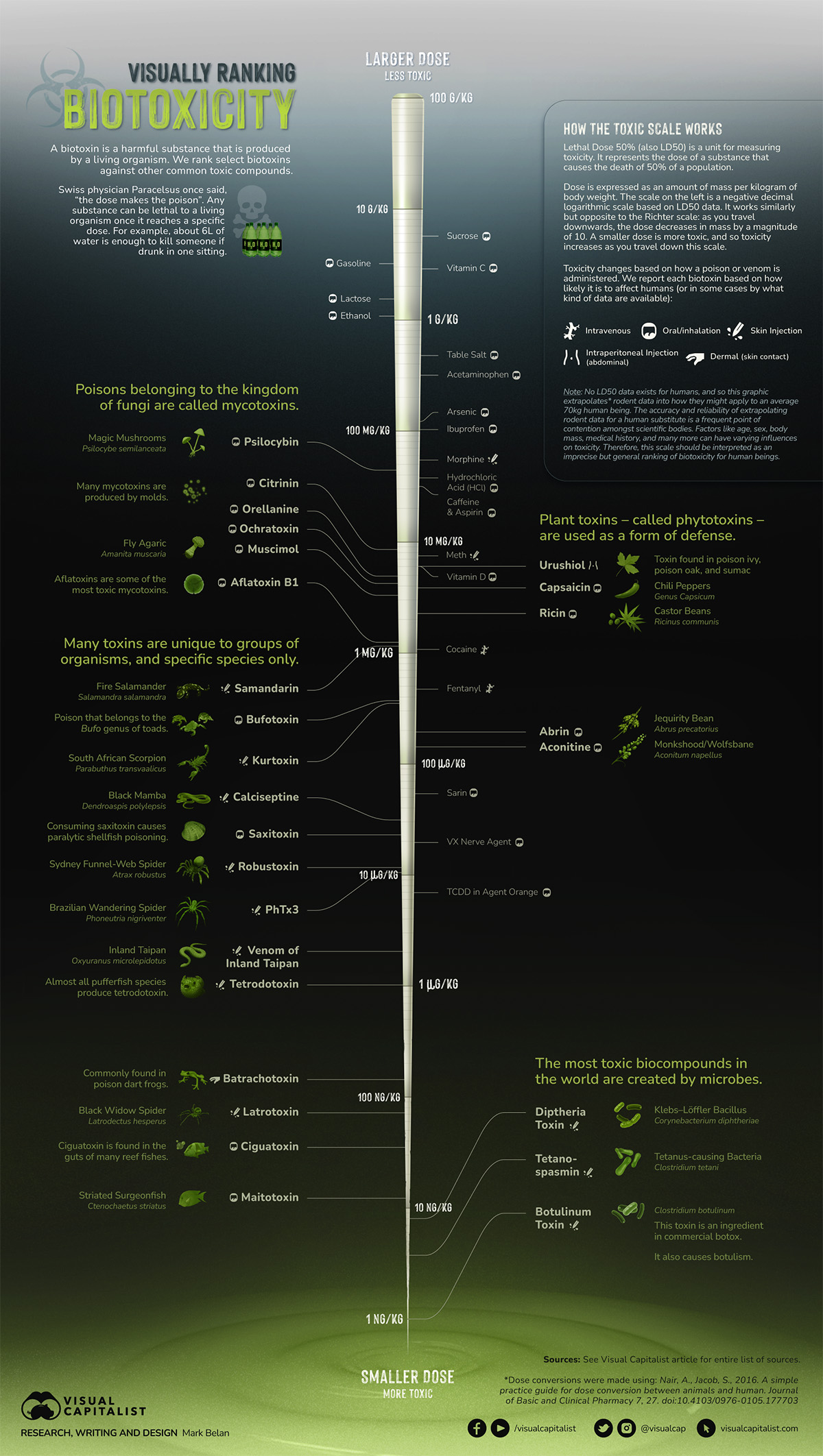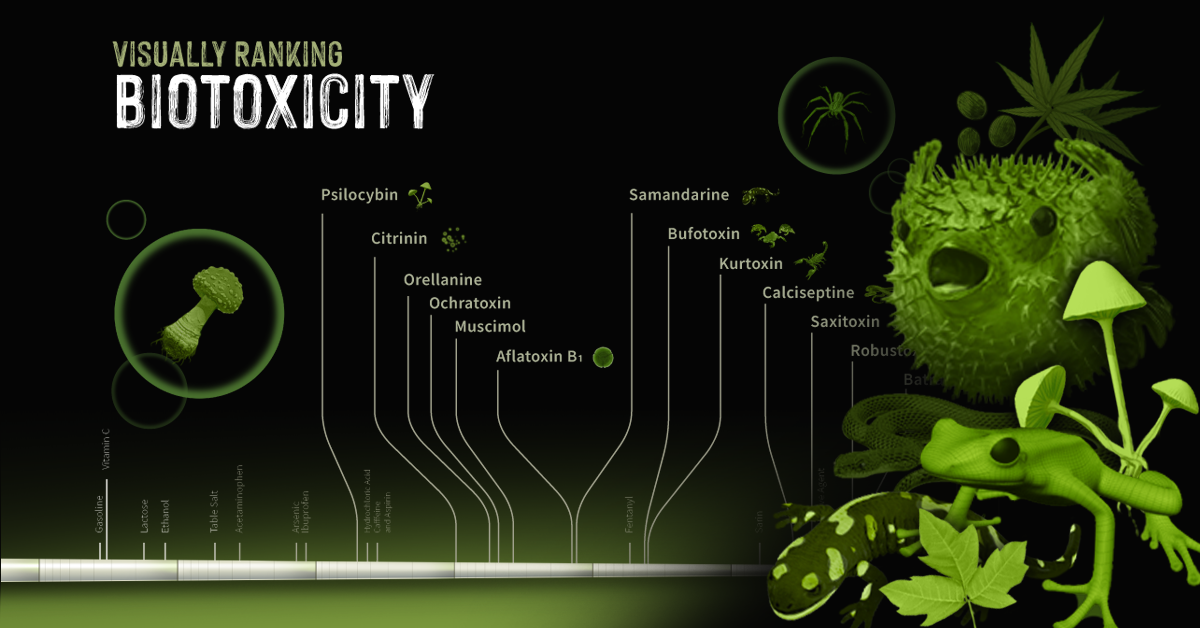Misc
Ranked: Biotoxins in Nature, by Lethal Dose
View the full-size version of this infographic
Biotoxins: Poisons of the Natural World
Biotoxins are harmful substances that come from living organisms.
They can take many forms, from the venom of a snake or spider to the neurotoxins produced by certain types of algae or microbes.
In the infographic above, we look at some common biotoxins in the natural world and rank them based on how deadly they are to an average 70 kg (154 lb) human being.
Ranking Biotoxins on a Toxic Scale
A basic concept in toxicology is that “only the dose makes the poison”. Everyday harmless substances like water have the potential to be lethal when consumed in large enough concentrations. Measuring a lethal dosage is very difficult.
First, living things are complex: factors like size, diet, biochemistry, and genetics vary across species. This makes it difficult to qualify toxicity in a universal way.
Second, individual factors like age or sex can also affect how deadly a substance is. This is why children have different doses for medications than adults.
Third, how a poison is taken into the body (orally, intravenously, dermally, etc.) can also impact its deadliness.
As a result, there are many ways to measure and rank toxicity, depending on what substance or organism is under investigation. Median lethal dose (LD50) is one common way for measuring toxicity. LD50 is the dose of a substance that kills 50% of a test population of animals. It is commonly reported as mass of substance per unit of body weight (mg/kg or g/kg). In the graphic above, we curate LD50 data of some select biotoxins found in nature and present them on a scale of logarithmic LD50 values.
What’s surprising is just how potent some toxins can be.
Bits and Bites about Biotoxins
While one would think that biotoxins are avoided at all costs by humans, the reality is more complicated. Here are some interesting facts about biotoxins present in nature, and our unusual relationships with the organisms that create them:
1. Fungi and molds make poisons called mycotoxins
Mycotoxins are a global problem. They affect crops from many countries, and can cause significant economic losses for farmers and food producers.
2. Phytotoxins can defend plants…and attack cancer
Plants use phytotoxins to defend themselves other organisms, like humans. Urushiol, for example, is the main toxic component in the leaves of poison ivy, poison oak, and sumac. But the Pacific yew tree produces taxol that’s valuable in chemotherapy treatments.
3. Fire salamander toxin is an ingredient in Slovenian whisky
Though not widely available, some whisky makers in Slovenia use samandarine from the fire salamander to create a psychedelic alcohol.
4. Ciguatoxins exist in the guts of reef fish
Very unique species of bacteria living in the digestive tract of reef fishes make ciguatoxin. They transmit this poison to other organisms when the host fish is eaten.
5. Pufferfish are deadly, but also delicious
Pufferfish contain tetrodotoxin, a potent neurotoxin in their ovaries, liver, and skin called tetrodotoxin. Despite being a delicacy in many countries around the world, it has a lot of strict regulations because of its ability to kill people. In Japan, for example, only specially licensed chefs can prepare pufferfish for consumption.
6. Batrachotoxin is lethal to the touch
The skin of some poison dart frogs secretes a deadly substance called batrachotoxin. It is so potent that simply touching the poison can be fatal. Indigenous people of Central and South America used batrachotoxin to poison the tips of hunting weapons for centuries.
7. Botox contains the most deadly biotoxin known
Commercial botox uses an extremely small amount of biotoxin from a microbe called Clostridium botulinum. It paralyzes the muscles, preventing contraction (i.e. wrinkling). It is the deadliest known biotoxin on Earth. One gram of botulinum toxin can kill up to one million people.
Caveats of Measuring and Reporting Biotoxicity
While we use LD50 data to rank biotoxicity, it isn’t an exact science. There is room for improvement.
For starters, no LD50 data exists for humans. That means data from other organisms has to be converted to apply to humans. There is a lot of contention amongst scientific communities about how accurate this is.
There has also been an increasing effort to move to new methods of measuring toxicity that are not harmful to animals. Several countries, including the UK, have taken steps to ban the oral LD50, and the Organisation for Economic Co-operation and Development (OECD) abolished the requirement for the oral test in 2001.
Now, new ways of evaluating toxicity are under investigation, like cell-based screening methods.
Correction: Water was mislabeled on a previous version of the infographic. Full sources here
China
How Do Chinese Citizens Feel About Other Countries?
What is the Chinese public’s view of world powers? This visual breaks down Chinese sentiment towards other countries.

Public Opinion: How Chinese Citizens Feel About Other Countries
Tensions over Taiwan, the COVID-19 pandemic, trade, and the war in Ukraine have impacted Chinese sentiment towards other countries.
This visualization uses data from the Center for International Security and Strategy (CISS) at Tsinghua University to rank survey responses from the Chinese public on their attitudes towards countries and regions around the world.
Chinese Sentiment Towards Other Countries in 2023
In the Center’s opinion polls, which surveyed a random sample of more than 2,500 Chinese mainland adults in November 2022, Russia came out significantly ahead.
Just under 60% of respondents held Russia in a favorable view, with 19% seeing the country as “very favorable.” Contrast that to the mere 12% that viewed the U.S. in a positive light.
Here’s a closer look at the data. The percentages refer to the share of respondents that voted for said category.
| Country/Region | Very Unfavorable | Somewhat Unfavorable | Neutral | Somewhat Favorable | Very Favorable |
|---|---|---|---|---|---|
| 🇺🇸 United States | 37.4% | 21.7% | 28.7% | 9.2% | 3.0% |
| 🇯🇵 Japan | 38.4% | 19.1% | 29.4% | 10.7% | 2.3% |
| 🇮🇳 India | 25.4% | 25.2% | 41.5% | 6.7% | 1.3% |
| 🇰🇷 South Korea | 17.4% | 21.0% | 47.6% | 11.8% | 2.1% |
| 🇪🇺 European Union | 9.3% | 15.6% | 57.6% | 14.1% | 3.3% |
| Southeast Asia | 7.1% | 13.1% | 59.5% | 16.8% | 3.5% |
| 🇷🇺 Russia | 3.0% | 4.8% | 33.7% | 39.4% | 19.0% |
Japan ranked just below the U.S. in terms of overall unfavorability, though a slightly higher share of respondents saw Japan as “very unfavorable” compared to America. This is likely due to both modern tensions in the East China Sea over mutually claimed islands and historical tensions over the Sino-Japanese Wars.
Chinese sentiment towards India was also unfavorable at just over 50%, though notably the country also received the lowest favorability rating at just 8%.
Additional Survey Findings
The survey also found that 39% of Chinese people get their information on international security from Chinese state-run media (mainly through TV), with an additional 19% getting information from government websites and official social accounts. Conversely, only 1.7% get their news from foreign websites and foreign social media, partially due to the Great Firewall.
When asked about different international security issues, the biggest shares of Chinese citizens ranked the following as their top three:
- Pandemics (12.9%)
- Disputes over territory and territorial waters (12.9%)
- China-U.S. relations (12.0%)
The pandemic’s high score reflects the harsher impact COVID-19 had on China. Chinese borders were shut for years and the public faced intense measures to reduce spread.
In terms of other world events, the majority of Chinese people align with a more “Eastern” viewpoint. For example, in regards to the war in Ukraine, the report found that:
“About 80 percent of the respondents believe the U.S. and Western countries should be held most accountable [for the war], while less than ten percent of the respondents argue that Russia is mainly responsible.”– Center for International Security and Strategy, Tsinghua University
Overall, the views of the Chinese public reflect the opposite of those found in many Western countries. They provide an important insight that it is not just the Chinese government holding particular views about the world, but the Chinese public as well.
-

 Markets3 weeks ago
Markets3 weeks agoHow Big is the Market for Crude Oil?
-

 Maps7 days ago
Maps7 days agoMapped: The Safest Cities in the U.S.
-

 Markets2 weeks ago
Markets2 weeks agoRanked: The Most Profitable U.S. Companies, by Sector
-

 apps5 days ago
apps5 days agoHow Long it Took for Popular Apps to Reach 100 Million Users
-

 Markets4 weeks ago
Markets4 weeks agoThe World’s Biggest Mutual Fund and ETF Providers
-

 Brands2 weeks ago
Brands2 weeks agoBrand Reputations: Ranking the Best and Worst in 2023
-

 Green5 days ago
Green5 days agoHotter Than Ever: 2023 Sets New Global Temperature Records
-

 Datastream4 weeks ago
Datastream4 weeks agoCan You Calculate Your Daily Carbon Footprint?



















